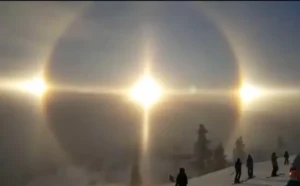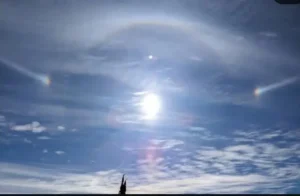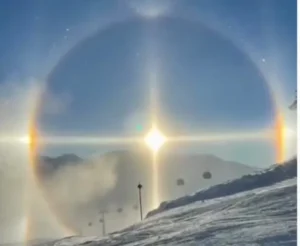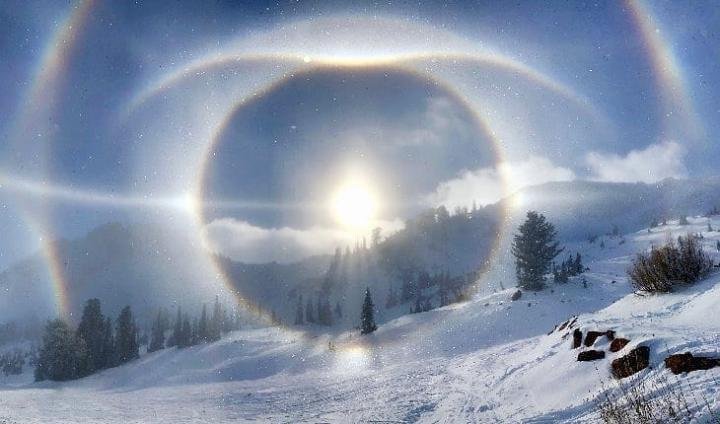3.Experience the Magic of Solar Parhelia: The Sky’s Own Mirage
Have you ever witnessed a second sun shining along with the real sun at the sky? If yes, you might seen a Solar Parhelia, also known as Sun Dog or Mock Sun. This enchanting phenomenon of atmosphere is created by the refraction of light from the sun through ice crystals in the atmosphere, making a truly magical sight.

What are Solar Parhelion?
Solar parhelia are shining spots of light that can be seen on either side of the sun, mostly within a 22° halo. They are formed when sunlight passes through hexagonal ice crystals in cirrus or cirrostratus clouds. These ice crystals act like tiny prisms, bending the sunlight and creating the colorful patches we see as sun dogs.
Read More: “Sun dogs in the skies: What is a parhelion?“
How do Solar Parhelion Form?
Formation of solar parhelion is caused by the fascinating interplay of light from the sun, ice crystals, and their orientation of them for the refraction of light.
Ice Crystals:
The key components in this phenomenon are the ice crystals, mostly hexagonal plate-shaped, commonly found on the high-altitude cirrus or cirrostratus clouds. They act like small prisms which scatter the light for the magical sight in the atmosphere.
Refraction of Sunlight:
When light from the sun enters the ice crystals, it is refracted, passing through the crystal’s face. The angle of refraction of the sunlight is determined by the specific angle of crystal’s face. In the case of solar parhelion, the sunlight is refracted at an angle of 22 degrees, because they appear at that distance from the sun.
Dispersion:
When sunlight passes through the crystals, it is dispersed into its constituent colors, just like prism which scatters the light into different colors. That’s why sun dogs make spectrum of colors, which make the sight more fascinating to its viewers.
Key Factors:
1. Orientation of Ice Crystals:
The orientation of the ice crystals are essential for the formation of the solar parhelion as they are responsible for the bending of sunlight to specific angle to form colorful effects of light ranging from faint-colored halos to vibrant solar duplicates surrounding the sun, depending on conditions. Sunlight is dispersed into constituent colors as it passes through the ice crystals just like the prism. That’s why, solar parhelia often exhibits spectrum of colors, with red mostly appearing closest to the sun.
2. Sun’s Position:
Sun dogs are most commonly seen when the sun is low in the sky, near the horizon. This is because the sunlight then passes through the ice crystals at an angle that favors the 22-degree refraction needed for sun dog formation.

What do Solar Parhelion Look Like?
Color:
Solar parhelia can be mostly seen as colorful patches of light. Red is mostly closest to the sun and violet is on the outer edge. However, the colors are usually muted and may overlap.
Brightness:
There brightness can vary significantly. Sometimes there are dim patches of light while other times they can be as bright and shining as the sun. That’s why, it is named as “mock suns”. Solar parhelia are the delicate spectral twins of the sun. In rarer instances, they can blaze with an intensity that rivals the Sun itself, creating a truly awe-inspiring spectacle – a celestial mirage where the Sun seems to multiply, casting its radiant glow across the sky.
Shape:
They often display as distinct spots of light, emerge as elongated streaks, sparking like jewels across the celestial canvas. Sometimes, they can even merge into a larger halo around the Sun.
Position:
They typically appear as a pair of bright spots of light, located at a distance of about 22 degrees to the left and right of the Sun.

Also Read: “Geminid Meteor Shower to Light up Skies: A Slow Explosion“
When and Where can you see Solar Parhelion?
Solar parhelion can be seen anywhere in the world, but they are most common in winter when ice crystal clouds are more frequent. They are also more likely to be seen when the sun is low in the sky, near the horizon, such as during sunrise or sunset. Sun dogs are most visible in toronto when the temperature hovered around 0 degrees celsius.
How to Spot Solar Parhelion?
If you want to witness the solar parhelion, you should look for cold whether with clear sky when the sun is near the horizon either rising or setting. it is best to look for the cirrus or cirrostratus clouds, which are the type of clouds that contain the ice crystals for the refraction of light from the sun for the formation.
Witnessing a solar parhelion is an unforgettable experience. So the next time you find yourself gazing at the sky on a crisp winter day, take a moment to look for these celestial wonders. You might be rewarded with a glimpse of the magical, a reminder that the universe is constantly unfolding before our eyes, offering moments of awe-inspiring beauty.

